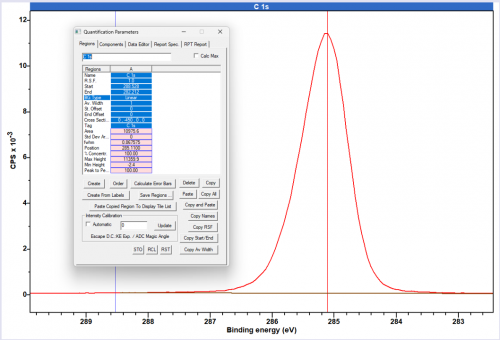

Background Types
One of the issues with XPS quantification is removal of a suitable background. The background signal itself comes primarily from the inelastic scattering of electrons which fail to escape during photoemission. Incorrect application of a background will result in analytical errors and incorrect quantifications.  Linear, Shirley and Tougaard backgrounds applied to Fe(2p) spectrum
Linear, Shirley and Tougaard backgrounds applied to Fe(2p) spectrum

This method, derived by D.A. Shirley, takes an S-shaped background for each peak, with the shape iteratively defined by background intensity at low and high binding energies and the intensity of each peak intensity. This method has the effect of reducing asymmetry in the peaks. This was initially design to describe the valence band XPS of an Au 4f spectrum, and as such works particularly well at very low BE. It is often recommended for general use to the ease of use and resulting minimisation of errors in data analysis.

The Tougaard background (also known as the universal cross-section approach) is an approach for integrating the intensity of the background at a given binding energy from the spectral intensities to higher kinetic energies. The figure below shows the three different types of background described here. The green area underneath each peak shows the inelastic background signal which is removed by the employed background subtraction method. From the signal removed, it is evident the background plays a significant part in successful data analysis and the same background should typically be used throughout your analysis.

Polymers, and systems with very low levels of post-peak background can be fit with a linear background without issues. Practically speaking, there is minimal difference between applying a Shirley background vs linear background at these levels – so either can be used, and in fact, if you are modelling multiple regions and are using Shirley in any of them then you should be consistent in your background selection across your dataset.

- Neal Fairly, XPS lineshapes and Curve Fitting in Surface Analysis by Auger and X-ray Photoelectron Spectroscopy ed. D Briggs & JT Grant, IM Publications, Chichester UK, 2003, p. 398.
- M.P. Seah Quantification of AES and XPS in Practical Surace Analysis by Auger and X-ray Photoelectron Spectroscopy ed. D Briggs & M.P.Seah , John Weley & Sons, Chichester UK, 1983 p. 204.
- High-Resolution X-Ray Photoemission Spectrum of the Valence Bands of Gold – D.A. Shirley – APS, Phys . Rev.
- Quantitative analysis of the inelastic background in surface electron spectroscopy – Tougaard, SIA, Wiley
- Comparison of background removal methods for XPS – SIA, Wiley
- “Peak fitting in XPS” – CasaXPS